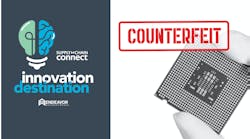The problem of counterfeit parts is not new, but many in the industry believe it is getting worse and that more bogus components are being introduced into the supply chain.
The blame for counterfeit parts is often placed at the doorstep of independent distributors that are not authorized to buy directly from component manufacturers. Instead they purchase parts from excess inventories of OEMs or electronics manufacturing services (EMS) providers, or other independent distributors and sometimes from authorized distributors. In some cases, the exact origin of parts sold by some independent distributors or parts brokers is not known. They may have been bought and sold several times before being sold to an OEM or EMS provider.
The Electronic Components Industry Association (ECIA), which is comprised of component manufacturers, authorized distributors and sales reps, says that buyers should purchase parts only directly from component manufacturers or from authorized distributors.
It is a sound strategy, but many buyers at OEMs and EMS providers still purchase from independent distributors when parts are in short supply, such as during the 2011 earthquake and tsunami in Japan and flooding in Thailand, which disrupted electronics production. Counterfeiters exploit such events, supplying the open market with bogus parts for high-demand components.
Some buyers also make opportunistic purchases from independent distributors even when there are no shortages because they can get a better price for the parts from independent distributors than from authorized distributors or component makers.
As a result, buyers have to share some of the blame for the proliferation of parts in the electronics supply chain. When a counterfeit part shuts down a production line or causes the failure of a piece of equipment in the field, it means somewhere in the supply chain, a buyer did not do his or her due diligence concerning a supplier. Honest, competent and legitimate suppliers don't knowingly sell counterfeit parts.
Buyers often take great pains to evaluate the capabilities of semiconductor and other component manufacturers and qualify them before placing orders. Shouldn’t buyers also make the same effort, or perhaps even a greater effort, with independent distributors, who do business on the open market where counterfeit parts enter the supply chain?
Most large electronics OEMs buy the bulk of their requirements directly from component manufacturers. However, they also buy from distributors during times of shortages. Their first choice often is authorized distributors, but they will sometimes purchase from independent distributors as well. Those distributors have been carefully screened, evaluated and qualified prior to the purchase and often are on the OEM’s approved vendor list.
Many large OEMs know that not all independent distributors are created equal. Some have no inventory and are basically parts brokers and may have a history of selling substandard or counterfeit parts. Others have large inventories and sophisticated business operations, and they carefully screen and test parts in an effort to guarantee authenticity. They may never have sold an illegitimate part.
While such screening and testing is not a guarantee that a counterfeit part will not be sold, it does weed out bad parts and reduces counterfeit risk.
While the problem of counterfeit parts will likely never disappear from the supply chain, strategic buyers can greatly reduce the risk that their companies ever purchase bogus components. If buyers are not going to buy from component manufacturers or authorized distributors, they owe it to their companies and to the supply chain to qualify any supplier they plan to buy from on the open market.







